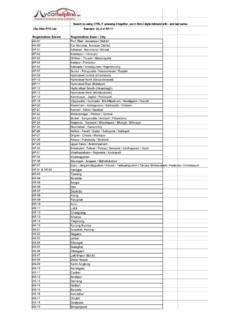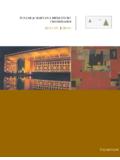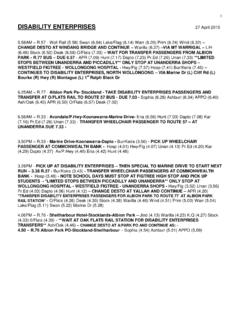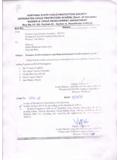Transcription of SYLLABI FOR BACHELOR OF EDUCATION (B.Ed.) - KENT
1 SYLLABI FOR BACHELOR OF EDUCATION ( ) Two-Year Regular Course AS per NCTE Framework 2014 DEPARTMENT OF EDUCATION CHAUDHARY RANBIR SINGH UNIVERSITY jind -126102 (HARYANA) (Estd. by Govt. of Haryana Legislature Act No. 28 of 2014) YEAR-1 COURSE-I: CHILDHOOD AND GROWING UP Time: 3 Hours Max. Marks: 100 Credits-4 (Theory: 80, Internal: 20) NOTE FOR PAPER SETTER i) Paper setter will set 9 questions in all, out of which students will be required to attempt 5 questions.
2 Ii) 1 will be compulsory and will carry 16 marks. There will be 4 short-answer type questions of 4 marks each to be selected from the entire syllabus. iii) Two long answer type questions will be set from each of the four units, out of which the students will be required to attempt one question from each unit. Long-answer type questions will carry 16 marks each. iv) All questions will carry equal marks. OBJECTIVES After completion of the course, student teachers will be able to: explain the meaning, concept and characteristics of growth, maturation and development at various stages describe the problems of childhood and adolescent age especially with respect to the Indian context develop an understanding of different aspects of a child s physical, intellectual, social and moral development analyze the impact of urbanization.
3 Globalization and economic changes on construction and experience acquired by growing child develop an understanding of dimensions and stages of childhood development and developmental tasks; with a focus on cognitive views of learning as well as social cultural and constructivism explain the concept of individual differences and its implications enlist the factors influencing individual difference differentiate between classical and operant conditioning theory of learning explain the Piaget s concept of cognitive development differentiate between Kohlberg s theory of moral development and Erikson theory of psycho-social development describe the role of teacher in teaching learning
4 Situations explain the concept and principles of different perspectives in learning describe childhood in the context of poverty and globalization COURSE CONTENT UNIT- 1 Development of Child at different Stages (Childhood and Adolescence) Concept, Meaning and general principles of Growth and development. Stages of development growth and development across various stages from infancy to adolescence. (Physical, intellectual, social and moral development.) Piaget s concept of cognitive development, Kohlberg s theory of moral development Erikson s psycho-social development theory Factors affecting Growth and development Relative role of heredity and environment in development.
5 Concept of growth and maturation Parenting styles: influencing developmental aspects of childhood and adolescence. Impact of Media on growing children and adolescents: deconstruction of significant events that media highlights and creates. UNIT- 2 Understanding Individual Difference Concept of individual difference, Factors influencing individual difference, Educational implications of individual differences for teachers in organizing educational activities. Dimensions of differences in psychological attributes-cognitive, interest, aptitude, creativity, personality and values.
6 Understanding individual from multiple intelligences perspective witha focus on Gardrner's theory of multiple intelligences. Implications for teaching-learning Understanding differences based on a range of cognitive abilities learning difficulties, slow learners and dyslexics, intellectual deficiency, intellectual giftedness. Implications for catering to individual variations in view of difference rather than deficit perspective. Methods and Ways to understand Children s and Adolescents Behaviour: Gathering data about children from different contexts: naturalistic observations; interviews; reflective journals about children; anecdotal records and narratives Meaning, characteristics and kinds of Play; Play and its functions: linkages with the physical, social, emotional, cognitive.
7 Games and group dynamics, rules of games and how children learn to negotiate differences and resolve conflict. UNIT-3 Theoretical Perspectives to enhance Learning among Children and Adolescents Learning: Meaning, implicit knowledge and beliefs. Perspective on Human Learning: connectionists or Behaviorist (Thorndike, Classical and Operant Conditioning) Cognitivist (Insightful learning, Tolman s Sign learning theory) Constructivism Bruner s discovery learning: Concepts and principles of each perspective and their applicability in different learning situations.
8 Relevance and applicability of various theories of learning for different kinds of learning situations. Role of learner in various learning situations as seen in different theoretical perspectives. Role of teacher in teaching learning situations. UNIT-4 Deprivation and Deprived Children: Measures for their Adjustment and EDUCATION Childhood in the context of poverty and globalization Current issues related to adolescents stress and role of the teacher (Increasing loneliness, changing family structures and rising permissiveness) Issues in marginalization of difference and diversity Children living in urban slum, socially deprived girls.
9 Measures to bring improvement in their status Child rearing practices of children separated from parents practices of children s separated children in cr ches; children in orphanages Schooling: peer influences, school culture, relationships with teachers, teacher expectations and school achievement; being out of school, overage learner Understanding needs and behavioral problems of children and adolescents: Relationships with peers: friendships and gender; competition and cooperation, competition and conflict; aggression and bullying from early childhood to adolescence substance abuse, drug addiction, Impact of globalization, urbanization and economic changes on construction and experience of children in childhood and adolescent age.
10 Tasks & Assignments: Any one of the following (10 marks) Administer any two of the following Psychological Tests and prepare a report on it: Intelligence Test Personality Test Self-Concept Questionnaire/ Inventory Creativity Learning Style Inventory Parenting Style Inventory Interest Test Teaching Attitude Conduct a case study on a problematic Child ( , , , , disruptive behavior and delinquent child etc.) and prepare a report on it. Prepare an observation schedule and observe the behavior of child in school setting.





